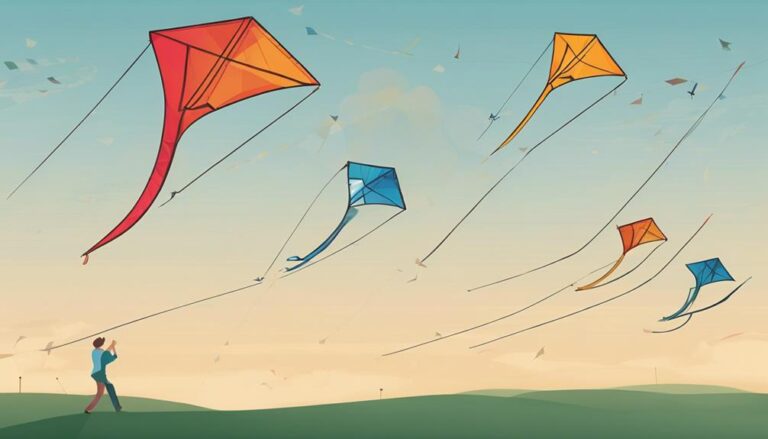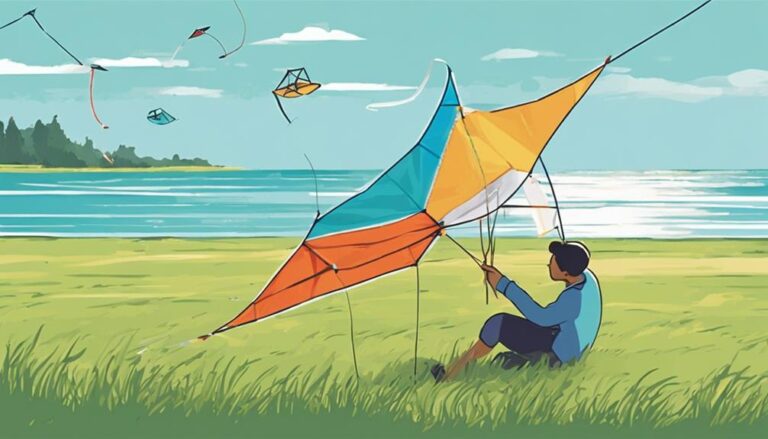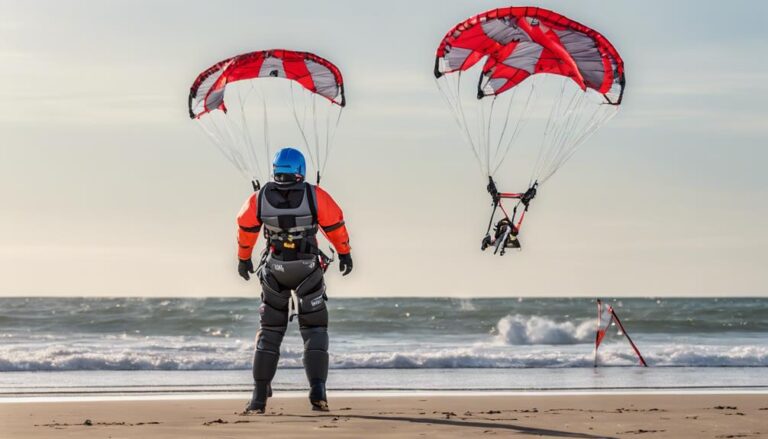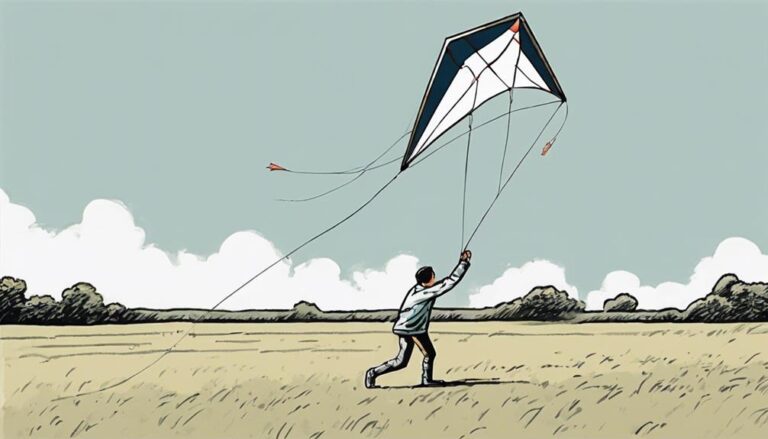Selecting your first power kite for landboarding is like navigating through a dense forest—you need the right guide to find your path.
You’ve probably got a lot of questions about where to start, what to look for, and how to avoid common pitfalls. Let’s cut through the noise together.
You’ll want to consider the size of the kite, its control system, and how it matches your skill level, among other things. But there’s more to the story, including tips that could save you time and frustration as you embark on this thrilling journey.
Stick around, and let’s explore these essentials that could make or break your landboarding experience.
Contents
Understanding Power Kites

Before diving into the thrilling world of landboarding, it’s essential to grasp the basics of power kites, the engines behind your adventure. Power kites are the soft canopy marvels that fuel extreme sports like landboarding. They’re not just about pull and traction; they’re about control and finesse, lifting you off your feet and propelling you forward with exhilarating speed.
Brands like Flexifoil and Ozone offer a range of sizes, each suited to different styles and conditions. Whether you’re maneuvering with a two-line or mastering the precision of a four-line kite, understand that your choice impacts your control and safety. Remember, your kite’s size and control system, alongside factors like body weight and wind conditions, are pivotal to your landboarding journey.
Always prioritize safety and control to ensure an unforgettable adventure.
Choosing Your First Kite
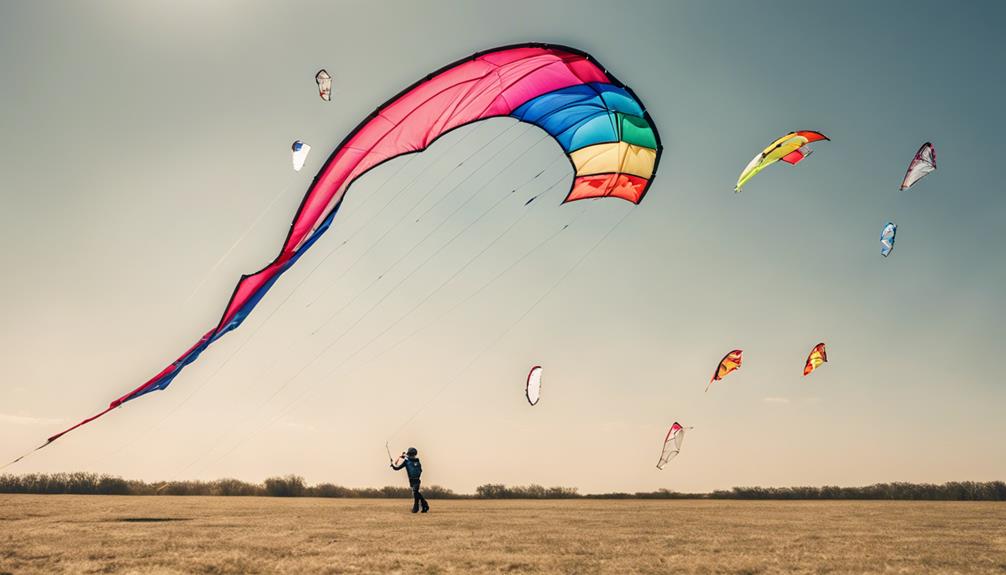
Now that you understand the fundamentals of power kites, it’s time to pick the right one for your landboarding endeavors. Consider beginner-friendly options like the Flysurfer Viron, available in sizes ranging from 2.5m to 8m, perfect for those just starting out.
The HQ4 Apex, with sizes of 5.5m, 8m, and 11m, is designed for both land and snow, offering versatility. Don’t overlook the Flysurfer Peak3, tailored for beginners with sizes of 4m and 6m, ensuring a smoother progression in your skills.
Look for kites with features like safe depower, user-friendly controls, and easy relaunch to make your learning experience as smooth as possible. Opting for kites with good stability, control, and depower capabilities is key to effectively enhancing your landboarding skills.
Trainer Kites Explained
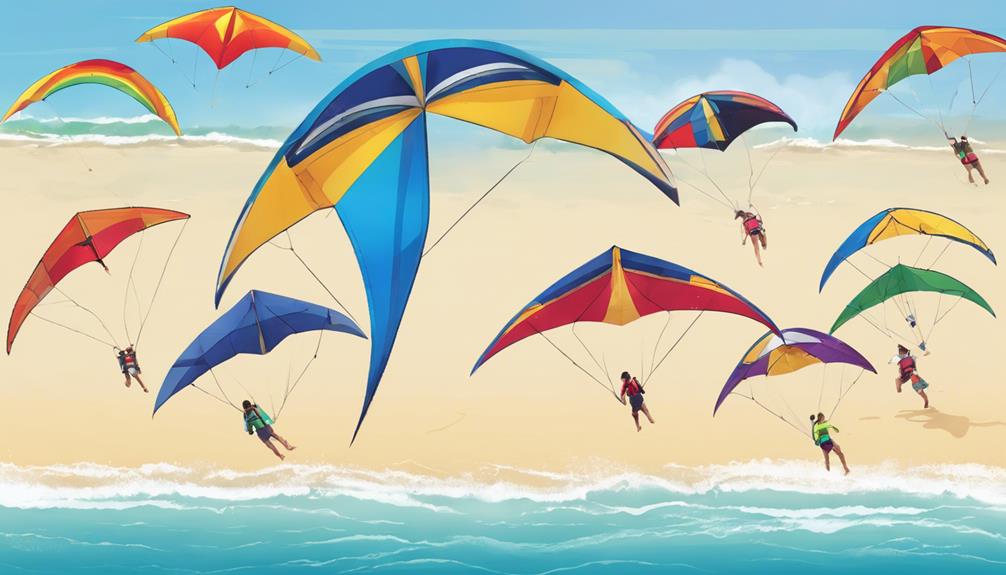
Diving into the world of power kites, it’s essential to start with a trainer kite to master the basics of kite flying in a safe and controlled manner. Trainer kites, designed specifically for beginners, are small and easy to control, ranging between 1.5m to 3m in size. This manageable introduction allows you to grasp wind dynamics, steering techniques, and power management without feeling overwhelmed.
They’re the ideal first step for practicing on land, laying a solid foundation before you transition to more intense activities like kite landboarding or kitesurfing. Embracing a trainer kite is a crucial move in building your confidence and proficiency, ensuring you’re well-prepared to handle larger power kites for your thrilling extreme sports adventures.
Landboard Selection Guide
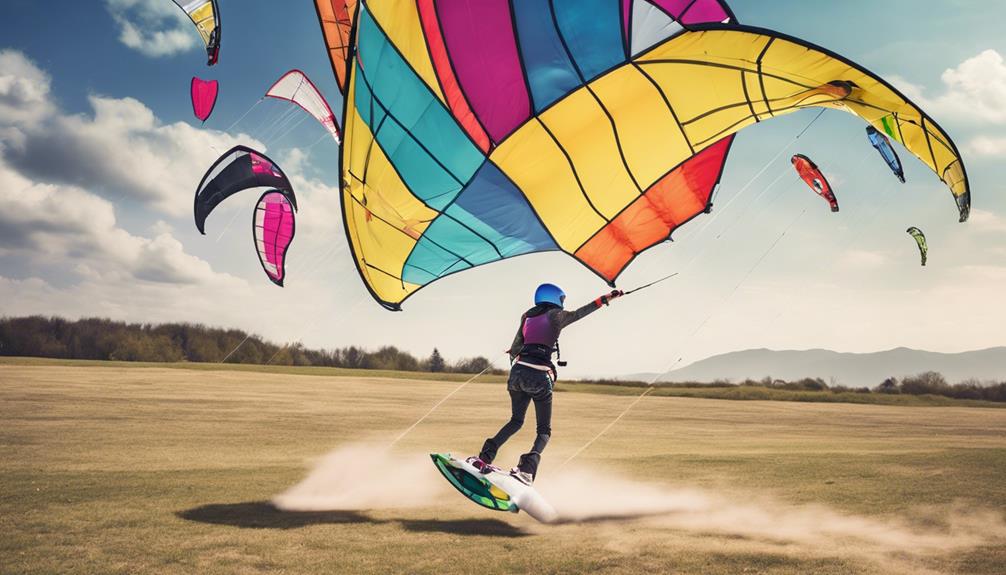
Selecting the right landboard is a critical step in ensuring your landboarding experience is both thrilling and safe. It’s not just about the power; it’s about having the right landboard under your feet.
| Feature | Why It Matters |
|---|---|
| Size (90-110cm) | Offers stability and control, crucial for beginners. |
| Durable Construction & Flex | Enables jumps and tricks, enhancing the fun. |
| Adjustable Bindings | Ensures a comfortable and secure fit, keeping you safe. |
Opt for a landboard with pneumatic tires for smooth rides over varied terrains. Moreover, a brake system is a must-have for added safety, especially during descents. Remember, the right landboard can significantly impact your landboarding journey, making it essential to choose wisely.
Harnessing the Wind
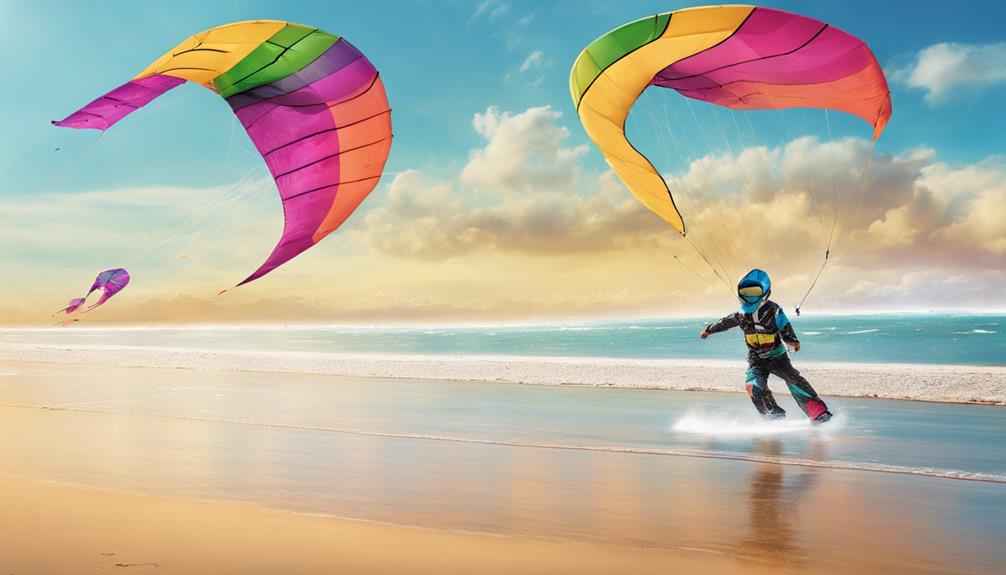
To harness the wind effectively for landboarding, it’s vital to first understand the basics of wind direction and speed. Properly adjusting your harness attachment point enhances stability and power management, crucial for controlling your kite at varying wind speeds. Opting for a waist harness gives you freedom, while a seat harness supports during longer rides.
- Feel the thrill as you glide effortlessly, powered by the wind.
- Experience the rush of executing perfect jumps and turns.
- Enjoy the freedom of movement, making every ride unforgettable.
- Relish in the comfort that comes with mastering kite control.
Harnessing the wind efficiently is key to maximizing your landboarding experience. It’s not just about the ride; it’s about the seamless dance between you, your kite, and the wind speeds that propel you forward.
Safety Gear Essentials
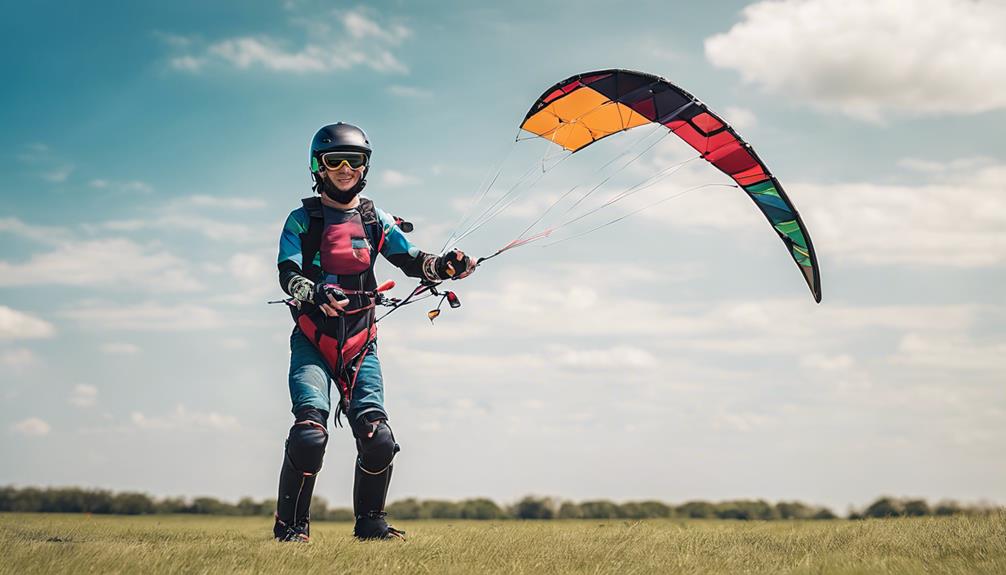
Why should you prioritize your safety gear when embarking on your landboarding adventure?
Well, it’s simple: to stay in the game and avoid injuries. Your safety gear essentials are your first line of defense against the unpredictable. A certified helmet is a must-have to shield your head from falls, which are inevitable as you learn.
Don’t overlook wrist guards; they’re crucial for preventing wrist injuries as you get the hang of controlling the kite and board. Knee and elbow pads offer extra cushioning and protect these joints from scrapes and impacts.
And let’s not forget proper footwear with ankle support. It’s essential for maintaining stability and preventing ankle injuries. Remember, safety first ensures the fun lasts.
Basic Flying Techniques
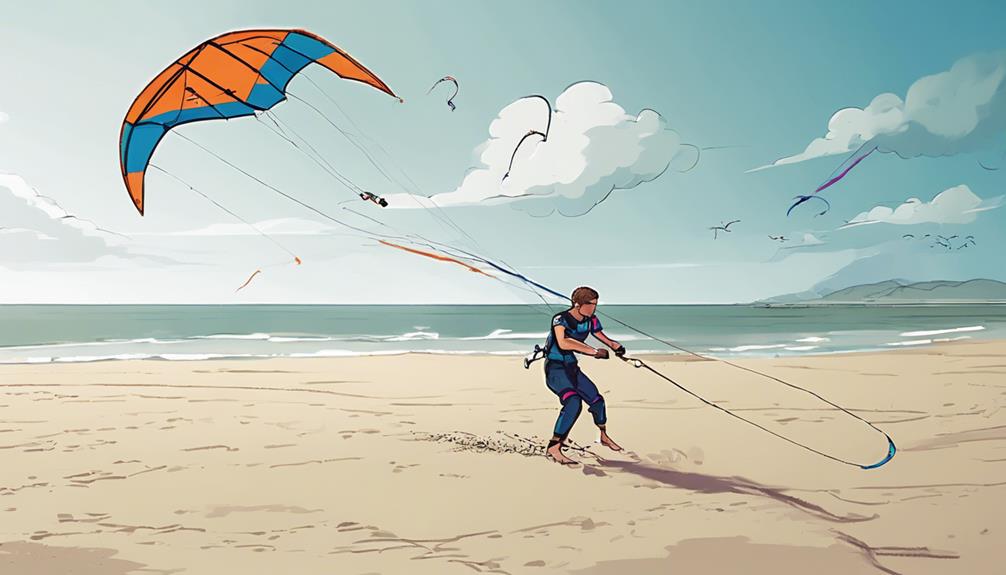
Mastering basic flying techniques is crucial for safe and effective landboarding. It all starts with learning how to steer your power kite accurately. Whether you’re using a fixed bridle kite or exploring static flying, the foundation of your skills begins here.
- Practice steering the kite by pulling the right and left lines, feeling the thrill as you command its direction.
- Learn to generate power by flying in a figure-eight, the kite dancing in the wind under your control.
- Utilize the wind window, moving from 9 O’clock to 3 O’clock, harnessing the wind’s force like a maestro.
- Master kite looping to keep your speed and momentum, turning potential crashes into smooth glides.
Mastering Landboarding Basics
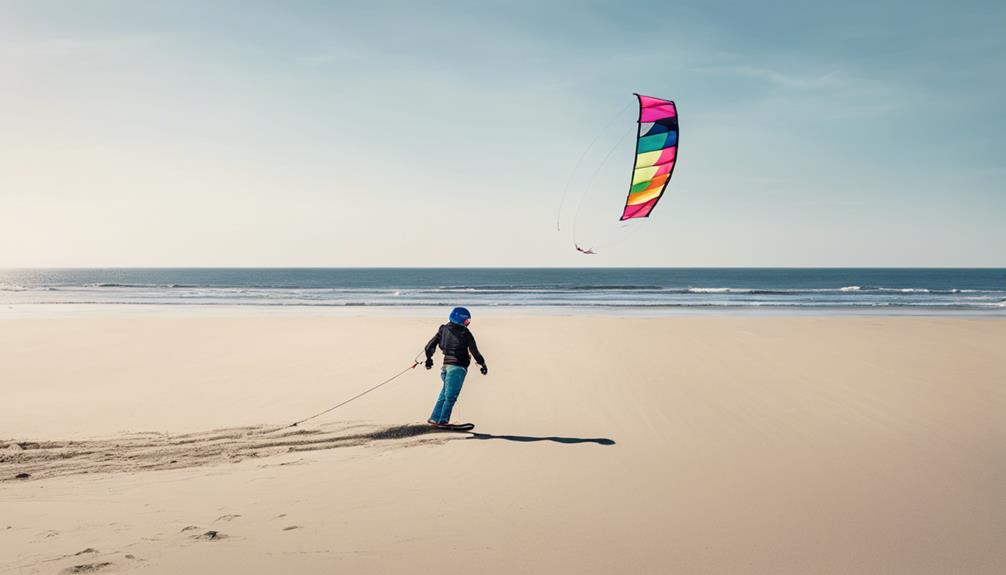
As you progress to mastering landboarding basics, choosing the right equipment is crucial; start with a smaller power kite (2-3m) for better control.
Mastering essential techniques, like steering the kite for power and balancing on the board with knees bent, will ensure a safer ride.
Always use wrist safety leashes and familiarize yourself with the safety systems to minimize risks on your landboarding journey.
Choose Your Equipment Wisely
When starting your landboarding journey, it’s crucial to select equipment that’s not only beginner-friendly but also prioritizes your safety and ease of learning.
Choosing the right power kite, such as the Flysurfer Viron, HQ4 Apex, or Flysurfer Peak3, is essential for mastering the basics effectively. These kites are known for their good balance, easy setup, and ability to provide a smooth learning curve.
- Feel the thrill of mastering landboarding with the right equipment by your side.
- Experience the confidence of having a kite that offers immediate and safe depower.
- Enjoy the satisfaction of a kite that’s easy to set up, letting you focus on the fun.
- Relish in the progress you’ll make with a kite designed for maximum control and stability.
Learn Essential Techniques
Now that you’ve chosen the right equipment, it’s crucial to focus on mastering essential techniques to ensure your landboarding journey is both thrilling and safe. Start by practicing with a smaller kite (2-3m) to get comfortable with kite control.
| Technique | Why It’s Important | Tips for Beginners |
|---|---|---|
| Balance on Landboard | Keeps you stable and in control | Keep knees bent, weight evenly distributed |
| Diving the Kite | Generates power for movement | Practice in mild conditions |
| Speed Control and Stopping | Prevents accidents, gives you control | Lean into heels to slow down or stop |
| Steering | Essential for navigation and fun | Master left and right kite movement first |
| Starting with Smaller Kite | Easier to control, less overwhelming | Begin with 2-3m kites to learn basics |
Weather and Location Tips

Selecting the right weather and location is crucial for a safe and enjoyable landboarding experience. When you’re ready to dive into kite landboarding, staying safe is paramount. Here are some tips to help you make the best choices:
- Choose open areas with consistent wind flow; it’s the foundation of your adventure.
- Opt for locations like sandy beaches or open fields, where your rides are as smooth as your dreams.
- Check for obstacles like trees or buildings that may hinder your control and freedom.
- Consider wind strength and direction to ensure each ride leaves you exhilarated, not deflated.
Ideal terrain, such as hard sand or flat surfaces, enhances maneuverability, making your landboarding journey not just about learning, but about thriving in the right conditions.
Progressing Your Skills

Mastering the art of flying a trainer kite is your first step in progressing your landboarding skills, ensuring you’re equipped to handle the power and nuances of larger kites safely. Start with a smaller power kite, around 2-3m, to build confidence. This size is easier to learn with and provides a solid foundation in varied wind conditions.
Focus on mastering basic techniques like steering, power generation, and speed control. As you become more comfortable, gradually increase the kite size. This gradual progression is essential in becoming proficient.
Additionally, seek guidance from experienced kiters or instructors. They’ll teach you what you need to learn, including advanced maneuvers, making your journey into landboarding smoother and safer.
Conclusion
As you embark on your landboarding journey, always remember to start small and prioritize safety. Choose your gear wisely, with a focus on control and versatility. Practicing with a trainer kite in a safe, open area is crucial before progressing.
Embrace the basics of kite flying and landboarding, and never underestimate the importance of weather awareness. As your skills advance, keep pushing your limits, but always with caution. Remember, consistency and safety gear are your best allies in mastering this thrilling sport.


